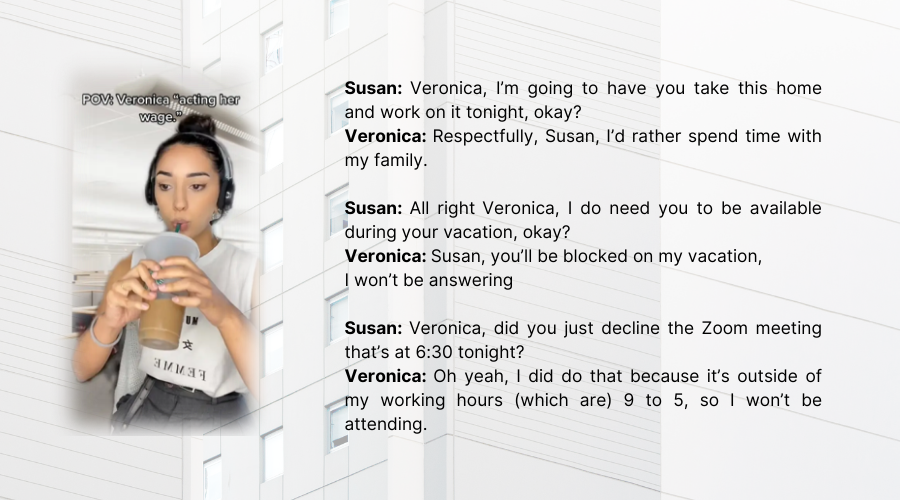What is Quiet Quitting and How to Avoid it
Learn what quiet quitting is with our complete guide. Recognize its early signs, ways to prevent quiet quitting's takeover, and ways to overcome it.
On this page
It started with a 17-second video by Zaid Khan (@zaidlepplin), where he described a concept that resonated with millions: doing your job—no more, no less.
This viral moment gave rise to a workplace phenomenon now known as quiet quitting. Shortly after, TikToker Sarai Marie (@saraisthreads) amplified the trend with relatable skits, spotlighting employees silently stepping back from hustle culture.

So, what is quiet quitting exactly? It’s not about resigning—rather, it's the conscious decision to stop going above and beyond at work, choosing instead to meet expectations without overextending. While some see it as reclaiming work-life balance, for employers, it’s a red flag of disengagement.
According to Gallup study, disengaged employees cost businesses $7.8 trillion in lost productivity globally. Clearly, this is more than a social media trend—it’s a wake-up call.
In this blog, we explore what’s driving quiet quitting, its impact, and most importantly, how to avoid quiet quitting in your organization through empathy, communication, and smart engagement strategies.
What is quiet quitting?
While there are several interpretations of ‘quiet quitting,’ it generally means quitting the hustle culture with its debilitating work pressure and long hours. It refers to doing only the bare minimum at work instead of going ‘above and beyond’ to impress the bosses and advance their careers.
The almost meteoric rise in popularity of ‘Quiet quitting’ can be attributed to the pandemic and a radically shifting workplace environment. Remote working blurred the lines between home and office, and people began to question the need for prioritizing work at the expense of family and personal life. Active social media discussions revolved around the impact of burnout on mental, physical, and social life as more and more workers began to reject the notion of the live-to-work culture.
Now, as businesses struggle to return to normal amidst a pitched battle for the sustentation of remote working, many employees are re-evaluating how they live, spend their time, and what is important about their jobs. The ‘quiet quitting’ movement paves the way to setting healthy boundaries at work, eliminating exhaustion, and renegotiating a healthier work-life balance.
Stories about quiet quitting
The internet is full of people going cold turkey on their jobs. It’s not just the blue-collar workers, but even executives have started chiming in with their own stories of quiet quitting after struggling with deteriorating mental health, non-existent social life, and the exacting task of balancing work and family. Some, having lost loved ones to the pandemic, were struck with the realization that they’d missed crucial moments in life due to the overwhelming pressure of work. Others waxed eloquent about being able to reconnect, rejuvenate and replenish.
While these stories paint a larger picture, what does quiet quitting look like on the ground?

The economics of quiet quitting
Reports show that these are not isolated cases; at least half of Gen Z’ in the U.S. (and others globally) are mentally and emotionally withdrawing from their demanding workloads and less-than-empathetic bosses.
Maria Kordowicz, associate professor and director of the center for interprofessional education and learning at the University of Nottingham, maps the relationship between quiet quitting and the concurrent rise in job resignations by linking the phenomenon to a noticeable drop in engagement.
Gallup’s global workplace report for 2022 traces this wave of resignations to the rise of a new ‘empowered’ breed of employees who are leading the conversation around how the onus should be on the employers to remove the root cause of burnout. HBR’s latest study on the impact of managers on quiet quitting corroborates this by showing how work environment and leadership abilities are key factors in moving the needle towards productivity or disengagement.
Finally, weighing in on the immediate economic impact of quiet quitting, the U.S. Secretary of Labor, Marty Walsh, points to U.S. government data showing a startling drop in U.S. labor productivity this year. He says, "If you are an employer, you should catch on early enough that your employees aren't satisfied, aren't happy, and then there needs to be a dialogue, a conversation."
Top 5 signs to look for in quiet quitting
‘Quiet quitting’ captures the spirit of the ‘new normal’—a time when more employees are choosing to do just enough to get by, rather than going above and beyond. While it may not seem like a pressing issue at first glance, this silent form of disengagement can have a compounding effect on team morale, productivity, and ultimately, business performance.
As employee motivation dips, so does innovation and customer experience—affecting both revenue generation and ROI. Here are the top five warning signs to help managers spot quiet quitting before it impacts the bottom line:
1. Chronic disengagement
Employees who were once enthusiastic but now display ongoing disinterest or apathy are waving a red flag. This lack of motivation often stems from burnout, feeling undervalued, or disconnected from their work. They may meet deadlines, but their energy, passion, and initiative are noticeably absent.
2. Only meeting minimum expectations
Quiet quitters fulfill their basic responsibilities—but that’s it. They no longer seek to exceed expectations or take ownership beyond their immediate duties. Unlike highly engaged employees who find purpose in their roles, quiet quitters work purely transactionally, often lacking pride in their performance.
3. Avoidance of extra tasks or initiatives
One of the most telling signs is an employee’s reluctance to take on anything that falls outside their job description. Whether it’s volunteering for new projects, mentoring a colleague, or attending optional trainings, quiet quitters will quietly decline—signaling a shift away from organizational commitment.
4. Isolation from the team
Collaboration is often the first to suffer. Quiet quitters may avoid brainstorming sessions, team-building activities, or cross-functional projects. They tend to prefer working in isolation, limiting interaction to what’s strictly necessary—weakening team cohesion and trust.
5. Minimal engagement in meetings
Rather than being active contributors, quiet quitters often remain silent during meetings. They may show up but rarely speak, contribute ideas, or provide feedback. This disengagement can slowly erode the overall team dynamic and innovation pipeline.
By recognizing these behaviors early, leaders can proactively re-engage employees through open dialogue, personalized support, and a culture that values work-life balance and meaningful contribution. Preventing quiet quitting isn’t just about productivity—it’s about preserving the heart of your organization.
Contrasting views on quiet uitting
Questions about the pros and cons of quiet quitting as a strategy will doubtless continue to rage on. But quiet quitting is real and here to stay until companies decide to make an enlightened change to stop burnout by offering fair wages and taking steps to engage, challenge, and stimulate their employees.
However, not everyone is on board with the new concept. Some detractors argue that quiet quitters are shutting themselves off from pay raises and promotions because there will always be someone else to take their place.
Supporters
Since COVID, my priorities, values, who and what are important to me have shifted drastically. I now leave my office at the end of the day, not thinking about what I need to work on when I go home at night. I set boundaries for checking my emails and reaching out to co-workers during non-office hours. Most importantly, I am not anxious when requesting time off, taking personal days, or especially taking sick time. Before, it was something I would agonize over, and now it is something I can do without hesitation or worry.” Sara M., department manager
"Many of my friends work in Big Law, and while they're paid very well, the expectations placed on Associates are extremely demanding and often unfair/emotionally abusive. They can't or won't draw similar boundaries, often for fear of retaliation, but they all recognize the toll it takes on their mental and physical health. Many have left their positions as a result." Lane Sheldon, attorney
Detractors
“I have zero ability to do anything but do as my boss requires me. The idea that 'quiet quitting' fits any job besides the ones laden with keyboard strokes, spreadsheets, and meetings, is foolish. It feels like more of a realization by people, who were more than happy to work 24/7/365 chasing the almighty dollar, that their lives are wasted in pursuing more stuff. Now they are presenting some laughable notion of 'I just realized I work too much, but luckily I can afford to do less because no one will notice anyway!' as a paradigm shift in worker's rights. I am disgusted that this has become something people believe could be effective for most of the workforce.” James Holverstott, laborer
“Quiet quitting is doing the bare minimum required of you at work and being content with mediocrity. Advancement and pay increases will go to those whose level of effort warrants advancement and doing the bare minimum certainly does not." Pattie Ehsaei, workplace decorum expert
How to solve the quiet quitting crisis in 2025
This statement from Gallup shines a spotlight on the root cause of the quiet quitting crisis – employee engagement. It’s less about workers coasting by in their jobs and more about employees setting boundaries because they aren’t feeling valued or appreciated in their respective organizations.
Here are some things that can help both the employer and employee create a meaningful, balanced relationship to avoid quiet quitting.
1. Get them talking and be ready to listen
Talk to your employees and dig deep to find out their reasons for going quiet. Ask relevant questions about their workload and bandwidth, and determine if they’re satisfied with their current tasks/projects or need additional resources or learning.
- Open a two-way channel of communication.
- Ask for honest feedback about the company and leadership.
- Create an environment where your employees feel comfortable speaking up.
- Provide constant motivation and stimulation.
- Take the feedback and act on it to implement changes.
2. Balance performance and expectations
Sit down and assess your employees' workload, have meaningful conversations around performance goals, and reassess company expectations and how you can help balance the two. Establish proper boundaries between personal life and work.
- Have 1-to-1 meetings about performance goals and how to align them to the higher company vision.
- Encourage a healthy work/life balance with conversations around mental health.
- Encourage your employees to take time off to recharge and rest when sick to avoid burnout.
- Ensure your employees have adequate time and resources to complete their tasks.
- Find out if there are any blockers and how to remove/work around them to maintain high productivity levels.
- Empower your employees to work autonomously and utilize different skills to keep up their enthusiasm.
- Promote internal career development and progression.
3. Reward and recognize
Employees thrive on motivation and recognition. It’s essential to frequently appreciate your employees—not just for exceeding expectations, but also for consistently meeting them. Recognition should be timely, personalized, and meaningful.
With Empuls, you can move beyond annual award ceremonies and create an ongoing, immersive rewards and recognition experience that keeps employees engaged throughout the year. The platform enables:
- Personalized appreciation through social shout-outs, core value badges, and peer-to-peer recognition.
- Multiple types of awards—spot, nomination-based, jury awards, milestone celebrations, and service anniversaries—automated and easy to manage.
- A global rewards catalog offering gift cards, experiences, wellness options, and company swag across 100+ countries.
- Integration with popular work tools, so recognition happens seamlessly in the flow of work.
Pair this with a competitive compensation structure and a benefits package supporting physical, psychological, and financial wellness—and you’re well on your way to building a culture where employees feel seen, valued, and inspired to stay.
4. Create a culture of belonging and connection
Disengagement often stems from feeling disconnected from the organization’s purpose or values. Fostering a strong sense of community can make employees feel seen, heard, and appreciated—not just for what they do, but for who they are.
- Build community spaces using platforms like Empuls, where employees can join interest-based groups, celebrate milestones, and engage in informal conversations.
- Use town halls and internal social feeds to regularly communicate company wins and vision updates.
- Celebrate life events—like birthdays, work anniversaries, or team wins—to promote a culture of shared success.
- Encourage informal moments like virtual coffee chats or hobby clubs to humanize the workplace.
5. Actively seek and respond to feedback
Quiet quitting can also result from employees believing their opinions don’t matter. Regular employee feedback loops—when handled well—can be a game changer in re-engaging a disillusioned workforce.
- Use Empuls’ survey and feedback tools to run pulse checks, eNPS, and lifecycle surveys that capture real-time employee sentiment.
- Analyze feedback through people analytics and take action with data-backed insights.
- Close the loop by communicating what changes were made based on employee input—this builds trust and reinforces their voice in decision-making.
- Don’t limit feedback to exit interviews; start from onboarding and keep it continuous.
6. Make Wellbeing a Priority, Not a Perk
In a world where burnout is a leading cause of disengagement, organizations must go beyond token wellness days. Employees want holistic, ongoing support for their physical, mental, and financial wellbeing.
- Offer personalized perks and benefits through Empuls’ Perks & Benefits module, including early wage access, tax-saving allowances, wellness subscriptions, and more.
- Promote flexibility—whether it's hybrid work, asynchronous schedules, or mental health days.
- Equip managers with tools to regularly check in on employee well-being, using smart nudges from Empuls’ AI assistant, Em, to guide conversations.
- Encourage usage of benefits by showcasing real stories from employees who’ve found them helpful.
By combining empathetic leadership with the right tools, organizations can shift from simply preventing quiet quitting to cultivating an energized, loyal, and purpose-driven workforce. Platforms like Empuls enable this transformation by integrating communication, recognition, feedback, and wellbeing into a unified employee engagement strategy.
Conclusion: From quiet quitting to active engagement
Quiet quitting isn’t about laziness—it’s a signal. A signal that employees are craving more balance, purpose, and recognition in the workplace. It’s a response to burnout, misalignment, and a lack of meaningful connection—not a rebellion against work itself.
Organizations that want to reverse this trend must rethink how they engage, support, and value their people. Open communication, fair expectations, regular recognition, and a genuine investment in employee wellbeing can turn quiet quitters into active contributors.
Tools like Empuls make this transformation easier by empowering HR and managers to listen actively, reward meaningfully, and build an inclusive culture of belonging. The result? A motivated workforce that’s not just meeting expectations—but thriving well beyond them.
Now is the time to shift from reactive to proactive. Because when employees feel valued, they don’t quit quietly—they show up loudly. And they stay.


















